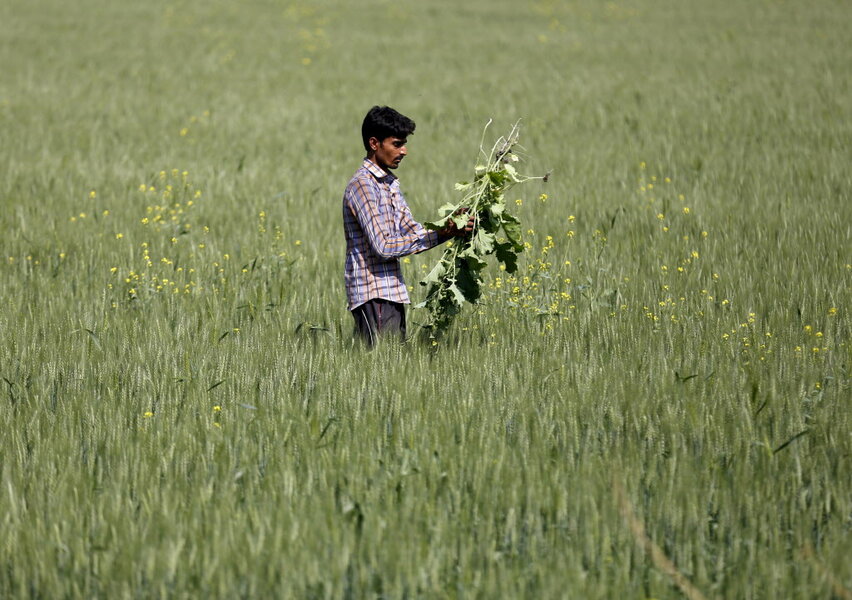Seven projects around the world that protect soil
Loading...
The International Year of Soils came to a close on December 4, but that won’t be the end of the work for many soil projects. According to United Nations Secretary-General Ban Ki-moon, “soils are the foundation of food systems” and “are critical to achieving food security and nutrition.” Without governance and investment in measures to promote sustainable soil practices, further soil degradation could have enormous implications.
Land degradation—which includes water erosion, salinization, and loss of biodiversity—“costs an estimated US$40 billion annually worldwide,” as reported by the UN Food and Agriculture Organization (FAO). Thirty-three percent of soil worldwide is degraded, and 50,000 square kilometers of soil are lost each year. Soil is not a renewable resource and “is not recoverable within a human lifespan,” but sustainable soil management could increase the world’s food production by 58 percent.
Professor John Crawford, a soil expert at the University of Sydney, advises that ignoring this issue will cause two major problems: a loss of soil productivity and a water crisis, “[hitting] the poorest countries hardest.”
Thankfully, farmers and scientists are finding ways to improve soils and increase food security. Here are seven influential projects and programs helping to restore the world’s soil:
- The African Conservation Trust (ACT): ACT runs a Soil Erosion Modeling Project in southern Africa, where “poor agricultural practices and overgrazing have resulted in massive losses of topsoil, the creation of huge dongas, and a loss of income earning potential to the local people.” After a successful gully rehabilitation project in 2010, which served to stabilize the soil in the Upper uThukela region of South Africa, ACT is beginning a project to model soil erosion for preventative action and subsequent protection of soil and livelihoods.
- The Hummingbird Project: Founded in 2010 by a husband and wife team, The Hummingbird Project uses education and permaculture principles for its Living Soil Saves Lives program, which trains rural farmers across India to use natural and organic farming techniques. This program specifically targets farmers in the so-called Suicide Belt, where the suicide rate among farmers is notoriously high. The Hummingbird Project has directly trained about 2500 farmers, and believes “strongly in the ‘train the trainers’ model,” according to co-founder Chris Kennedy.
- Kiss the Ground: An innovator in the battle against drought in California, Los Angeles-based Kiss the Ground uses media campaigns, community gardening, and networking to affect change for soil preservation. Their recent video, The Soil Story, encourages people to sign a petition asking the California legislature for an allocation of US$160 million for regenerative agriculture. Co-founder Finian Makepeace urges participation, saying that “healthy soil is something that everyone can support.” Kiss the Ground emphasizes the potential for healthy soil to sequester carbon, curbing climate change, as well as leading to better water supplies, improved farming, and restored habitats.
- RECARE: Funded by the European Union, RECARE is a project conducting 17 case studies on soil degradation and conservation across Europe. The goal of RECARE is to create measures for restoration of soil and degradation prevention for a variety of threats to soil health: desertification, soil erosion, salinization, soil compaction, flooding, contamination, and others. The project began in November of 2013 and is scheduled to come to a close in November of 2018. According to one soil scientist on the RECARE project, Artemi Cerda, “new farmers are not the same as those a few decades ago. They do not know the importance of soil within nature conservation.” Preserving fertile land and increasing the sustainability of productive agricultural soils is key to this project.
- The Red Soil Project: Based in Canada, The Red Soil Project educates rural Ugandan farmers in sustainable agriculture techniques, including soil building, composting, and mulching, using demonstrations and workshops in partnership with local organizations.
- The Rodale Institute: An independent agricultural research organization, The Rodale Institute conducts a variety of projects with the aim of identifying the ideal soil conditions for farming. Current projects include research on soil and carbon sequestration, the role of particular fungi in soil health and crop growth, and a long-term Farming Systems Trial, which has demonstrated many benefits of organic systems. Jeff Moyer, Executive Director of The Rodale Institute, reminds farmers and consumers that “healthy soils equal healthy food. And healthy food equals healthy people.”
- SOIL Haiti: SOIL aims to increase access to dignified sanitation, but is transforming Haiti’s depleted soil in the process. While using the rich organic compost produced through an ecological sanitation system, SOIL’s compost increases soil fertility and water retention, bringing yields as many four times those of farmers operating without SOIL’s compost. An innovative attempt at revitalizing soil and eliminating unwanted waste, SOIL’s founder Sasha Kramer notes that stakeholders “love that, by tackling one problem, the solution also benefits public health and the growing of food and other crops.”
This article first appeared in Food Tank.







